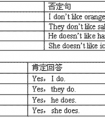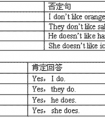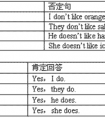找出下列句子中错误的选项,将其序号填入题前括号里。( ) 1.Youfarmisbeautiful. A B C D( ) 2.Arethosecow ? A B C D( ) 3.Ihavesomepotatosandcarrots. A B C D( ) -四年级英语
形式为单数,意义也为单数这类集合名词
包括baggage / luggage(行李), clothing(衣服), furniture(家具), machinery(机器), poetry(诗), scenery(风景), scenery(), jewelry(珠宝), equipment(设备)等。
其用法特点为:
是不可数名词,只用单数形式,不用不定冠词(当然更不能用数词),没有复数形式。
如:Our clothing protects us from [against] the cold. 我们的衣服可以御寒。
Have you checked all your baggage? 你所有的行李都托运了吗?
The thief stole all her jewelry. 小偷把她所有的首饰都偷走了。
The hospital has no decent equipment. 这家医院没有像样的设备。
The Tang Dynasty is thought of as the high summer of Chinese poetry. 人们认为唐朝是中国诗歌的全盛时期。
注:machinery, poetry, jewelry, scenery等相应的个体可数名词是 machine, poem, jewel, scene等。
如:a poem / a piece of poetry 一首诗
many machines / much machinery / many pieces of machinery 许多机器
第五类
补充几个常考的集合名词除上面提到的四类集合名词外,以下几个集合名词也应重点注意:
1. hair(头发,毛发)
指全部头发或毛发时,为集合名词(不可数);指几根头发或毛发时,为个体名词(可数)。
如:My hair has grown very long. 我的头发已长得很长了。
The police found two hairs there. 警察在那儿找到了两根头发。
2. mankind(人类)
人是一个不可数的集合名词,不用复数形式,也不连用冠词。
如:This is an invention that benefits mankind. 这是一项造福人类的发明。
Mankind has its own problems. 人类有自己的问题。
注:mankind 表示“mankind 人(类)”时,虽不可数,但有时却可以表示复数意义,尤其是当其表语是复数时。
如:Mankind are intelligent animals. 人是理智的动物。
3. fruit(水果)
作为集合名词,它通常是不可数的。
如:He doesn’t eat much fruit. 他不大吃水果。
He is growing fruit in the country. 他在乡下种水果。
但是,当要表示种类时,它可视为可数名词,即a fruit 指一种水果,fruits 指多种水果。
比较:fruits Some fruits have thick skins. 有些水果皮很厚。
The potato is a vegetable, not a fruit. 土豆是一种蔬菜,而不是一种水果。
考点名称:there be 句型
- There be句型:
是英语中常用句型,意思是“有”,表示“人或事物的存在”。
There在此结构中是引导词,已经没有副词“那里”的含义。
There be后面的名词是句子的主语,属倒装结构。常用“There + be+名词+地点/时间状语”的结构。 - There be结构的用法:
A、肯定结构:
There be句型的肯定结构表示“某处存在某物或某人”或“某时发生某事”。
a. There is+单数可数名词/不可数名词+地点/时间状语。
例:There is a cat under the chair. 椅子下面有一只猫。
There is some water in the bottle. 瓶子里有些水。
b. There are +复数名词+地点/时间状语。
例:There are some apples in the basket. 篮子里有一些苹果。
B、否定结构:There be句型的否定结构是在谓语动词be的后面加“not (any)”或“no”.
例:There are no tables in the room. 或者There are not any tables in the room. 房间里没有桌子。
C、疑问结构:There be句型变成疑问式时,要把there和谓语动词be的位置互换。
例:Is there a pen in the schoolbag? 书包里有一支笔吗? - Therebe结构和have的区别与联系:
1.区别点:
there be 意为存在,强调某地有某物,不表示所属关系;
have 表示所有关系, 强调某人或某地有某物,这是其基本用法。如:
There are some trees in front of the house.房前有些树。
Tom has many friends in China.汤姆在中国有许多朋友。
2.相同点:
在表示结构上的含有时,既可以用there be 句型,也可以用have(has) 来表示。如:
中国有许多长河。
There are many long rivers in China.
China has many long rivers.
三月份有多少天?
How many days are there in March?
How many days has March? - There be结构中的be动词的确定:
A、there be 结构中的谓语动词be在人称和数上应与其后的主语保持一致。主语是不可数名词或单数可数名词时用is,是复数时用are。
例:There is a flower in the bottle. 瓶里有一朵花。
There is some money in the purse. 钱包里有些钱。
B、若句子中有几个并列的主语时,be的形式要与离其最近的一个主语在人称和数上保持一致。
例:There is a boy, a girl and two women in the house. 房子里有一个男孩,一个女孩和两个妇女。
There are ten students and a teacher in the office. 办公室里有十个学生和一个教师。
There be结构的句型转换:
A、否定句:
there be的否定式通常在be后加not构成(在口语中be时常与not缩写在一起)。如果句中有some,一般要变成any。 例:
There are some children in the picture.
There aren't any children in the picture.
B、一般疑问句及其答语:
把be提到there前,首字母大写,句末用问号即可。其肯定答语是Yes, there is / are;否定答语为No, there isn't / aren't。 例:
— Are there two cats in the tree?
— Yes, there are. (No, there aren't.)
C、特殊疑问句及其回答
a. 提问句子的主语(包括主语前的修饰语)时,句型一律用“what is+地点介词短语?”(无论主语是单数还是复数都用is)。
例:There are some birds in the tree. → What's in the tree?
b. 就there be后面的地点状语进行提问时,句型用“where is/ are+主语?”
例:There is a car in the street. → Where is the car?
c. 提问可数名词(主语)前的数量时,用how many,句型结构为“how many+ 复数名词+are there+其它)”(主语无论是单数还是复数,be通常要用are)。
例:There are three books on the desk. → How many books are there on the desk?
- 最新内容
- 相关内容
- 网友推荐
- 图文推荐
上一篇:单项选择。—Whatisyoursister'sname?—nameisMary.[ ]A. HerB. MyC. SheD. His-四年级英语
下一篇:选词填空,将其序号填在横线上。A. brother's B. ThoseC. soD. yourE.Whose1.Isthisjacket?2. arehispants.3.capisit?4.It'smy.5.They'refunny.-四年级英语
零零教育社区:论坛热帖子
| [家长教育] 孩子为什么会和父母感情疏离? (2019-07-14) |
| [教师分享] 给远方姐姐的一封信 (2018-11-07) |
| [教师分享] 伸缩门 (2018-11-07) |
| [教师分享] 回家乡 (2018-11-07) |
| [教师分享] 是风味也是人间 (2018-11-07) |
| [教师分享] 一句格言的启示 (2018-11-07) |
| [教师分享] 无规矩不成方圆 (2018-11-07) |
| [教师分享] 第十届全国教育名家论坛有感(二) (2018-11-07) |
| [教师分享] 贪玩的小狗 (2018-11-07) |
| [教师分享] 未命名文章 (2018-11-07) |

![John _____________ an air-conditioner in _____________ bedroom.[ ]A. have, himB. has, hisC. has, he-五年级英语](http://www.00-edu.com/d/file/ks/4/1/23/2019-08-16/small54858f2c11067f43b6431ea11c99345f1565909294.png)


![What's his name? ____________ name is Li Ming. [ ]A. HisB. Her-三年级英语](http://www.00-edu.com/d/file/ks/4/1/23/2019-08-16/smallbf3f2eef41637228ad7cb0082b827bb31565909431.jpg)

